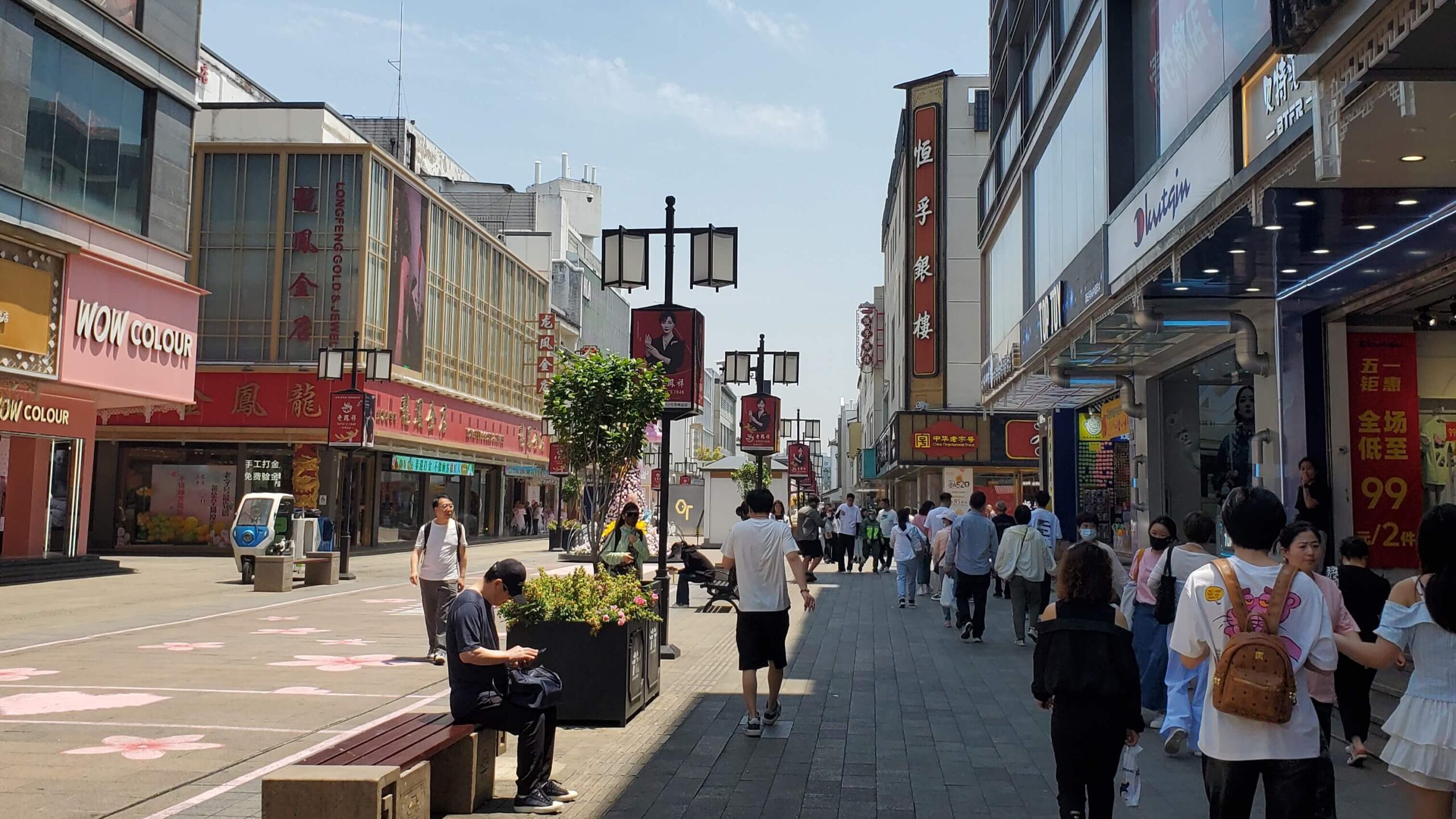In China, shopping isn’t just about ticking items off a list — it can be a whole experience. Even in this ultra-digital age, when you can order an air conditioner on your phone and have it installed the next day (true story, courtesy of our tour guide in Shanghai), lively shopping streets like this are still buzzing with energy. And today, our Suzhou travel itinerary leads us straight to the 150-year-old Guanqian shopping street.
Location to put in map: 观前街
Cost: Free
How to get there: By metro
Read my full Suzhou travel story
Jump to:
- The Trendy Part of Guanqian Shopping Street in Suzhou
- The Spiritual part of Guanqian Shopping Street: Xuanmiao Taoist Temple
- The Historic Soul of Guanqian Shopping Street
The Trendy Part of Guanqian Shopping Street in Suzhou
Stepping out of the metro, we follow the GPS until we find ourselves on a wide pedestrian avenue. Both sides of Guanqian Shopping Street are flanked by a vivid collage of signs and banners — Chinese characters mingling with English names, bright logos promising everything from ice cream to silk scarves. Clothing boutiques, souvenir shops, snack vendors, quirky toy stores… this part of Suzhou is a kaleidoscope of temptations.

If this isn’t quite the old-world Suzhou you pictured when I mentioned a 150-year-old shopping street, don’t worry — Guanqian Shopping Street has layers. It’s actually divided into three sections, and we just happened to start in the most modern one, that has the trendier shops.
So let’s lean into it. How about we grab a fun-flavored lemonade — the lychee-pomelo one is calling my name — and stroll through the crowd, peeking into colorful storefronts and soaking up the energy.
The lemonade is icy cold and wildly sweet — maybe too sweet — but in this heat, it’s exactly what I need.

The Spiritual part of Guanqian Shopping Street: Xuanmiao Taoist Temple
Just as you’ve settled into the rhythm of browsing, something on your left catches your eye — a beautiful building with an upward-sloping black tile roof, quietly guarded by stone lions. That’s the Xuanmiao Taoist Temple.

Dating all the way back to 276 AD, this temple is one of Suzhou’s oldest spiritual landmarks. Naturally, it’s been rebuilt many times over the centuries — as ancient structures often are — but its silhouette remains quietly captivating. And here’s a fun detail: Guanqian Shopping Street actually takes its name from this very temple. “Guanqian” literally means “in front of the temple.”
The doors of the temple are wide open and inside you can see a golden statue shimmering through the dark. I don’t recognise the deity but it looks quite fierce holding a sword or something similar.
There’s a peaceful courtyard further in, with incense burners smoking away and more halls waiting to be explored, but sadly, I’m not dressed appropriately for temple entry, so I will have to skip deep diving into this Suzhou attraction today.
With a lingering hint of regret, let’s turn away and continue exploring the rest of Guanqian Shopping Street.
The Historic Soul of Guanqian Shopping Street
Here the atmosphere shifts.
The glossy, boxy buildings of Guanqian Shopping Street we passed earlier give way to charming structures that echo traditional Chinese architecture — wooden balconies and the upward-curving corners of tiled roofs creating graceful silhouettes. Lanterns shaped like slender rectangular columns line the street, each adorned with delicate artwork. I can’t help but wonder how magical they must look, glowing softly after dark.

Amid these beautiful details, shopfronts nestle comfortably. Many have been part of this street’s rhythm for generations. I love wandering into the snack shops, inhaling tempting aromas, and browsing souvenir stores filled with playful food-shaped magnets and other tiny tokens of Suzhou’s unique charm.
Thoughts?
When I am at home, I am not into shopping at all. But the shopping streets in China, like the Guanqian Shopping Street in Suzhou, has such a charm that they evoke the feeling of wonder. You can never know what treasures you’ll find, so browsing around is always an adventure.
PS: if you’re planning a trip to China – check out my list of tips, tricks and things you need to know when planning a China trip. It covers the basics like payments, navigation and more.

Read my full China travel story

